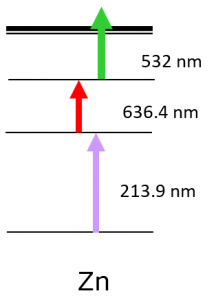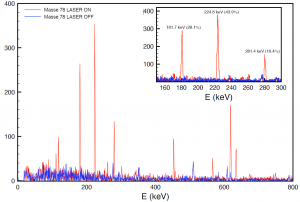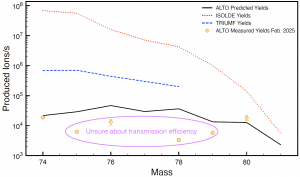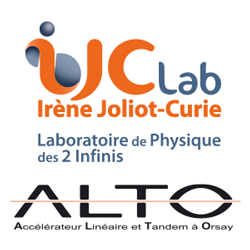In February 2025, during week 7, 3 months after the ALTO research platform was flooded, radioactive beams at 30 keV were once again produced in the ALTO-LEB area. Zinc and gallium beams were produced for the N-RI-14 and N-RI-20 experiments connected to the MONSTER detector (placed on the BEDO beamline).
The RIALTO experimental system was prepared for the production of radioactive zinc (Zn) and gallium (Ga) ion beams. Figure 1 shows the laser scheme used to ionize the zinc atoms produced by photofission. The 1st stage, which was tricky to achieve, was produced by frequency tripling the wavelength to 642 nm. The laser beams used to ionize the zinc or gallium atoms are sent collinearly through a 3 mm diameter tube (the ionization tube) at a distance of 18 meters. A position control system maintains their geometric stability throughout the experiment. Figure 2 shows the decay spectrum for mass 78 with and without lasers. We can see the expected peaks for zinc 78 in the 200 keV range.
Figure 3 shows the yield productions measured directly on the BEDO beamline. The black curve corresponds to measurements estimated by simulation, and the diamonds to yields production measurements performed between masses 74 and 80. Figure 3 also compares the yields productions in two other facilities where similar beams have been produced: ISOLDE and TRIUMF. The values measured in Figure 3 are preliminary, and a more detailed analysis is in progress.

Figure 1: laser scheme for zinc ionization

Figure 2: Decay spectrum of zinc 78 with and without laser. The detail at top right shows the three expected peaks.

Figure 3: Yields productions obtained at ALTO-LEB for masses from 74 to 80 during the February 2025 experiment. They are compared with the yields productions obtained for the same low-energy radioactive beams at ISOLDE and TRIUMF.












